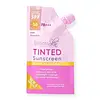What's inside
What's inside
 Key Ingredients
Key Ingredients

 Benefits
Benefits

 Concerns
Concerns

 Ingredients Side-by-side
Ingredients Side-by-side

Water
Skin ConditioningPanthenol
Skin ConditioningDimethicone
EmollientGlycerin
HumectantGlyceryl Stearate
EmollientPEG-100 Stearate
Cetearyl Alcohol
EmollientPhenoxyethanol
PreservativeCetearyl Dimethicone Crosspolymer
Butylene Glycol
HumectantAcrylates/C10-30 Alkyl Acrylate Crosspolymer
Emulsion StabilisingAllantoin
Skin ConditioningHyaluronic Acid
HumectantTriethanolamine
BufferingEthylhexylglycerin
Skin ConditioningHydrolyzed Hyaluronic Acid
HumectantCeramide NP
Skin ConditioningSodium Hyaluronate
HumectantCentella Asiatica Extract
CleansingCamellia Sinensis Leaf Extract
AntimicrobialPotassium Sorbate
PreservativeSodium Benzoate
MaskingWater, Panthenol, Dimethicone, Glycerin, Glyceryl Stearate, PEG-100 Stearate, Cetearyl Alcohol, Phenoxyethanol, Cetearyl Dimethicone Crosspolymer, Butylene Glycol, Acrylates/C10-30 Alkyl Acrylate Crosspolymer, Allantoin, Hyaluronic Acid, Triethanolamine, Ethylhexylglycerin, Hydrolyzed Hyaluronic Acid, Ceramide NP, Sodium Hyaluronate, Centella Asiatica Extract, Camellia Sinensis Leaf Extract, Potassium Sorbate, Sodium Benzoate
Water
Skin ConditioningEthylhexyl Methoxycinnamate
UV AbsorberCaprylyl Methicone
Skin ConditioningPEG-12 Dimethicone
Skin ConditioningSodium Acrylates Copolymer
Lecithin
EmollientTitanium Dioxide
Cosmetic ColorantNiacinamide
SmoothingDimethicone
EmollientCucumis Sativus Fruit Extract
EmollientGlycerin
HumectantCodonopsis Lanceolata Extract
AntioxidantEthylhexylglycerin
Skin ConditioningPhenoxyethanol
PreservativeChamomilla Recutita Extract
Skin ConditioningAloe Barbadensis Leaf Juice
Skin ConditioningAloe Ferox Leaf Juice Extract
Skin ConditioningCI 77891
Cosmetic ColorantCI 77492
Cosmetic ColorantCI 77491
Cosmetic ColorantCI 77499
Cosmetic ColorantParfum
MaskingXanthan Gum
EmulsifyingDisodium EDTA
Water, Ethylhexyl Methoxycinnamate, Caprylyl Methicone, PEG-12 Dimethicone, Sodium Acrylates Copolymer, Lecithin, Titanium Dioxide, Niacinamide, Dimethicone, Cucumis Sativus Fruit Extract, Glycerin, Codonopsis Lanceolata Extract, Ethylhexylglycerin, Phenoxyethanol, Chamomilla Recutita Extract, Aloe Barbadensis Leaf Juice, Aloe Ferox Leaf Juice Extract, CI 77891, CI 77492, CI 77491, CI 77499, Parfum, Xanthan Gum, Disodium EDTA
Ingredients Explained
These ingredients are found in both products.
Ingredients higher up in an ingredient list are typically present in a larger amount.
Dimethicone is a type of synthetic silicone created from natural materials such as quartz.
What it does:
Dimethicone comes in different viscosities:
Depending on the viscosity, dimethicone has different properties.
Ingredients lists don't always show which type is used, so we recommend reaching out to the brand if you have questions about the viscosity.
This ingredient is unlikely to cause irritation because it does not get absorbed into skin. However, people with silicone allergies should be careful about using this ingredient.
Note: Dimethicone may contribute to pilling. This is because it is not oil or water soluble, so pilling may occur when layered with products. When mixed with heavy oils in a formula, the outcome is also quite greasy.
Learn more about DimethiconeEthylhexylglycerin (we can't pronounce this either) is commonly used as a preservative and skin softener. It is derived from glyceryl.
You might see Ethylhexylglycerin often paired with other preservatives such as phenoxyethanol. Ethylhexylglycerin has been found to increase the effectiveness of these other preservatives.
Glycerin is already naturally found in your skin. It helps moisturize and protect your skin.
A study from 2016 found glycerin to be more effective as a humectant than AHAs and hyaluronic acid.
As a humectant, it helps the skin stay hydrated by pulling moisture to your skin. The low molecular weight of glycerin allows it to pull moisture into the deeper layers of your skin.
Hydrated skin improves your skin barrier; Your skin barrier helps protect against irritants and bacteria.
Glycerin has also been found to have antimicrobial and antiviral properties. Due to these properties, glycerin is often used in wound and burn treatments.
In cosmetics, glycerin is usually derived from plants such as soybean or palm. However, it can also be sourced from animals, such as tallow or animal fat.
This ingredient is organic, colorless, odorless, and non-toxic.
Glycerin is the name for this ingredient in American English. British English uses Glycerol/Glycerine.
Learn more about GlycerinPhenoxyethanol is a preservative that has germicide, antimicrobial, and aromatic properties. Studies show that phenoxyethanol can prevent microbial growth. By itself, it has a scent that is similar to that of a rose.
It's often used in formulations along with Caprylyl Glycol to preserve the shelf life of products.
Water. It's the most common cosmetic ingredient of all. You'll usually see it at the top of ingredient lists, meaning that it makes up the largest part of the product.
So why is it so popular? Water most often acts as a solvent - this means that it helps dissolve other ingredients into the formulation.
You'll also recognize water as that liquid we all need to stay alive. If you see this, drink a glass of water. Stay hydrated!
Learn more about Water